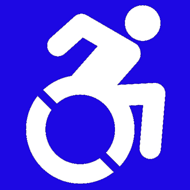Bias
Social Change Via Graphic Design
Combating social stereotypes with small changes to a familiar icon
Posted May 29, 2013
Little changes can make a big difference.
This is the principle underlying many a tweak to public policy or organizational procedure designed to nudge people to alter behavior. So for example, many of us have stayed in hotel rooms with signage asking us to think of the environment by hanging up and reusing towels. These signs can be effective, but especially so with a tiny tweak: learning that a high percentage of previous inhabitants of your very same room have reused their towels leads to significantly higher rates of compliance.

In the news this week is another effort to shape societal thought, this time by modifying an icon familiar to millions of Americans: the white-on-blue “handicapped” symbol. The movement has been rumbling in Boston for a while, as activists have been applying stickers with the new symbol to handicapped parking signs for several months. But now New York City has made things official and will start using the symbol beginning as soon as this summer.
As outlined here, the guiding principle of the changes to the symbol is to portray the iconic individual in an active, forward-moving manner, as opposed to the more passive, stationary old image. In the new icon the head tilts forward, the arm angle implies a wheel about to be (or having just been) spun, and the wheel itself appears in motion.

Such tweaks to visual imagery are made all the time, of course. Many a corporation alters its logo in the effort to update, modify, or otherwise refine its image. Take, for instance, Wal-Mart’s decision in 2008 to move from old-school block letters to a more modern font followed by a yellow spark. And other logos similarly seek to convey a particular message even if its broadcast outside of public awareness, such as the famous FedEx logo with the forward moving arrow hidden neatly between the E and x that many of us don’t consciously notice.
So it’s an interesting question whether this update to the familiar handicapped logo will have any effect, even small, on perceptions of individuals with disability. I’m tempted to ask, non-rhetorically, what you think: do you think it’ll shift, even slightly, people’s expectations about disability?
But my guess is most of us would quickly say no, it’ll have no effect. And my guess is also that this knee-jerk response is likely wrong. After all, how many of us would’ve thought that learning about the previous guests in Room 211 would dramatically change our own towel use when we stay in that room?
__
Like this post? Then see the website for Sam's book, Situations Matter: Understanding How Context Transforms Your World (now out in paperback!). You can also follow Sam on Facebook here and on Twitter here. Book trailer video here and below:


